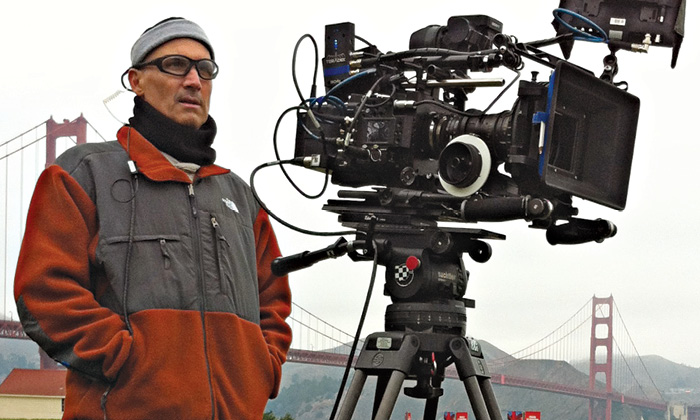
The PROfile: Sam Ameen '84
“War reduces everything to angles,” writes Sam Ameen ’84 in an essay about being a combat photographer in Afghanistan. There are the angles of bullets marked by tracers flying through the air. And there are the camera angles Ameen used to capture the chaos around him.
The Emmy-nominated Ameen has recorded both real and simulated combat in his career as camera-man and director of photography (DP) for documentaries, feature films and TV shows. The constant is choosing the right angles and perspective to convey the story unfolding before his lens.
His first look at the industry came as a Management major at Bentley. During an internship for NBC News, he found himself more interested in the work going on behind the cameras than in front of them. He began shooting documentaries after college and, in 1991, joined the Air Force.
Six years later, Ameen became part of the 4th Combat Camera Squadron, an independent military film unit dating back to World War II; the experience offered critical lessons in teamwork.
“When you deploy to a place where people are trying to hurt you,” he says, “you get very involved in the emotional state and welfare of those around you.”
Ameen took that comrades-in-arms approach to Hollywood, where his work includes films with director-actors Jon Voight and Anthony Edwards, TV shows like the ABC comedy Downward Dog, documentaries like the Holocaust-inspired Steal a Pencil for Me, and indie films like Chez Upshaw, a dark comedy about a couple running a B&B for assisted suicides. He holds DP credit for features that premiered at Sundance, Taos, Berlin and Locarno, among other film festivals. Every project requires checking his ego at the door to translate the vision of the director.
“They are the ultimate keepers of the keys,” says Ameen, who starts by presenting directors with a range of photos and clips from different sources. The goal is deciding on a common visual language that will help tell the story in a director’s head. “When you put yourself behind a director’s vision, you usually get a good film.”
On a documentary, by contrast, the cinematographer takes a more active role in how the story is told. “That’s often for the simple reason that the event is unfolding in front of you,” he explains, “and where you place the camera is fluid.”
Storytelling is taking an even more personal turn for Ameen. He’s working to find funding for his own documentary-in-progress, which will splice together combat footage with a narrative he wrote about the surreal contrast between real and fictional depictions of battle.
“There’s a weird split between doing narrative scenes with people wearing squibs” — miniature explosive devices that create the illusion of gunfire — “and people who are really dying in front of you on the floor of the helicopter.”
At the same time, he says, the act of framing, adjusting color and contrast, and captioning photos of trauma becomes strangely therapeutic, helping insulate him from PTSD. He hopes the finished work will engage viewers.
As Ameen writes: “My view — my angle — is the opposite of my infantryman-brother’s, who quickly takes an aggressive posture when strangers approach. Unlike his shot, mine is an expressive picture, so I invite contact.”
After so many years of helping express other people’s cinematic vision, he may finally get a chance to express his own.
Sam's Tricks of the Trade
Directors vary like actors:
Some never pick up a lens; others almost measure the height of the camera.
Every digital camera has its own palette:
Now instead of changing film stock, we change cameras.
The style must fit the script:
Pretty, stable and controlled is not always the right choice.

